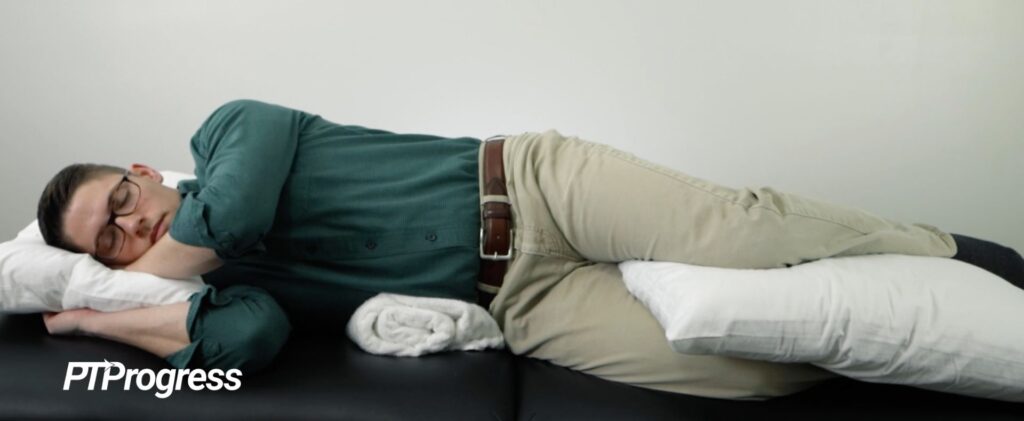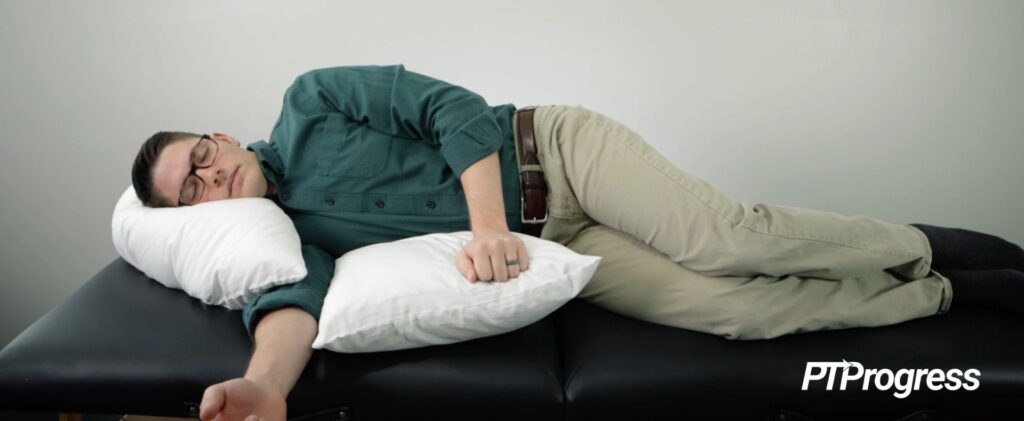
Did you know that the cause of your neck or back pain could be as simple as how you sleep? Sleeping posture plays an important role in spinal alignment, so if you’re sleeping out of whack, you’re more likely to wake up with pain.
In this article I’ll show you the best sleeping position for neck pain as well as how to modify other sleeping positions for optimal spinal health.
How to Avoid Neck Pain at Night
My PT patients are often surprised to learn that sleeping posture makes such a difference on pain. As long as you’re relaxed, it shouldn’t matter which way you sleep, right?
Not quite. A short nap is one thing, but sustaining a single posture for the better part of eight hours will undoubtedly affect your spine.

Quick Anatomy Lesson: Neutral Spine
When viewed from the side, a healthy spine has 3 major curves. First, it curves inward at the lumbar region, then curves outward in the thoracic region before curving back inward again at the neck or cervical region.
The spine should have no curves, however, when viewed from the front or back. We call this neutral spine. Maintaining a neutral spine will help you avoid neck or back pain during long-term activities such as standing or sleeping.
Not all sleeping positions allow for a neutral spine, and some of them will most certainly bring your spine out of its ideal alignment.
One such position is stomach sleeping, perhaps the worst bedtime posture for back and neck pain. So let’s take a closer look.
Stomach Sleeping
Although many people enjoy sleeping prone, the stomach sleeping position creates an exaggerated curve in the lumbar spine. And if you like to hug a bunched-up pillow as you sleep on your stomach, you may have an exaggerated thoracic curve as well.
Such extreme spinal curves end up putting pressure in your low back where it hinges, sometimes even causing a pinching feeling. By sustaining this posture, you’ll be more likely to wake up with back pain, and it’ll be harder for you to improve your posture if your thoracic spine is curved around a pillow for 8 hours every night.
If you’re a stomach sleeper, the best thing you can do for your spine is to flip over on your back. The next best thing is to consider modifying your sleeping position with a few well-placed supports.
Sleeping Tips for Stomach Sleepers
Radically changing sleeping positions isn’t easy, and you may feel it’s next to impossible. But if you’ve made a habit of stomach sleeping, you don’t need to accept back pain as your fate.

To mitigate any lower or upper back pain, try sleeping with a pillow under your hips to support your lumbar spine. This elevation will help reduce the hinge in your low back and reduce the pinching sensation.
Additionally, try to sleep on a smaller or thinner pillow. Although you’ll still need to keep your head turned a suboptimal 90 degrees in order to breathe on your stomach, a thin pillow will reduce the side bend in your neck and help you avoid other problems.
Speaking of problems, let’s now take a look at the second worst way to sleep if you have back and neck issues.
Side sleeping
Sleeping on your side is a much better position for your back than sleeping on your stomach. However, people with wide hips may encounter a unique set of aches and pains from this position.
Whenever you sleep on your side, your spine will naturally hinge at the point of your hips. If those hips are wide, then your spine will curve downward, out of neutral alignment. This unnatural curve may strain your lumbar region and make you wake up with an aching back.
Sleeping Tips for Side Sleepers
To alleviate the curve from your hips, place a rolled-up towel under your side, just above your hip bone. The towel will provide extra support for your low back, so that you can sleep on your side with less back pain.
Another trick for neutral side sleeping is to tuck a pillow between your knees. This is especially helpful if you’ve been experiencing pain in your hips or low back. The pillow between your knees prevents your legs from pulling your pelvis downwards and keeps everything aligned in a neutral spine position.

Finally, if you have shoulder or upper back pain but love to sleep on your side, there’s a modification for you too. Try placing a pillow beneath your head’s pillow and perpendicular to your torso, creating a sort of gutter for the arm you sleep on. This auxiliary pillow can also serve as a shelf for your opposite arm, which will help you avoid shoulder pain when side sleeping.

Best Sleeping Position for Neck Pain: Back Sleeping
Sleeping on your back is the best position for spinal health, but there are a couple ways to make it even more comfortable.

When you sleep on your back, focus on supporting your neck, especially the cervical curve in your spine. To do this, I often tell my patients to roll up a small towel and place it inside their pillowcase along the bottom edge of their pillow. The towel will create a small ridge for the neck and help reinforce the proper cervical curve of a neutral spine.
You can find plenty of ergonomic cervical pillows designed for this purpose, but it’s much cheaper to simply roll up a towel inside the pillow case you already have. Plus, you’ll be able to easily customize how much cervical support you need by adjusting the size or roll of the towel.
Another area that could benefit from additional support is your low back. Try placing a pillow under your knees when you’re sleeping supine. Propping the knees helps take some of the tension off the low back and can alleviate pain from sciatica and other low back injuries.
Improve Your Posture, Day and Night
Although your back or neck pain may be a result of how you sleep, I guarantee that the way you hold yourself throughout the day, standing or sitting, also plays a role.
Besides addressing your sleeping position, you may need to fix bad posture in order to eliminate your neck pain. Check out the rest of the blog for exercises to help straighten rounded shoulders, reset a forward head posture, or even shrink a dowager’s hump.
By improving your posture—both daytime and nighttime —you’ll realign your spine and relieve your back and neck pain.

